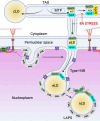Mechanisms for assembly of the nucleoplasmic reticulum
- PMID: 39367888
- PMCID: PMC11455740
- DOI: 10.1007/s00018-024-05437-3
Mechanisms for assembly of the nucleoplasmic reticulum
Abstract
The nuclear envelope consists of an outer membrane connected to the endoplasmic reticulum, an inner membrane facing the nucleoplasm and a perinuclear space separating the two bilayers. The inner and outer nuclear membranes are physically connected at nuclear pore complexes that mediate selective communication and transfer of materials between the cytoplasm and nucleus. The spherical shape of the nuclear envelope is maintained by counterbalancing internal and external forces applied by cyto- and nucleo-skeletal networks, and the nuclear lamina and chromatin that underly the inner nuclear membrane. Despite its apparent rigidity, the nuclear envelope can invaginate to form an intranuclear membrane network termed the nucleoplasmic reticulum (NR) consisting of Type-I NR contiguous with the inner nuclear membrane and Type-II NR containing both the inner and outer nuclear membranes. The NR extends deep into the nuclear interior potentially facilitating communication and exchanges between the nuclear interior and the cytoplasm. This review details the evidence that NR intrusions that regulate cytoplasmic communication and genome maintenance are the result of a dynamic interplay between membrane biogenesis and remodelling, and physical forces exerted on the nuclear lamina derived from the cyto- and nucleo-skeletal networks.
Keywords: Calcium; DNA damage repair; Extracellular vesicles; Nuclear envelope; Nucleoplasmic reticulum; Phosphatidylcholine.
© 2024. The Author(s).
Conflict of interest statement
The authours have no financial or non-financial interests to disclose.
Figures




Similar articles
-
The Dynamic Nature of the Nuclear Envelope.Curr Biol. 2018 Apr 23;28(8):R487-R497. doi: 10.1016/j.cub.2018.01.073. Curr Biol. 2018. PMID: 29689232 Review.
-
Condensins exert force on chromatin-nuclear envelope tethers to mediate nucleoplasmic reticulum formation in Drosophila melanogaster.G3 (Bethesda). 2014 Dec 30;5(3):341-52. doi: 10.1534/g3.114.015685. G3 (Bethesda). 2014. PMID: 25552604 Free PMC article.
-
Calcium release from ryanodine receptors in the nucleoplasmic reticulum.Cell Calcium. 2006 Jan;39(1):65-73. doi: 10.1016/j.ceca.2005.09.010. Epub 2005 Nov 9. Cell Calcium. 2006. PMID: 16289270
-
Border control at the nucleus: biogenesis and organization of the nuclear membrane and pore complexes.Dev Cell. 2009 Nov;17(5):606-16. doi: 10.1016/j.devcel.2009.10.007. Dev Cell. 2009. PMID: 19922866 Free PMC article. Review.
-
The Role of Lamins in the Nucleoplasmic Reticulum, a Pleiomorphic Organelle That Enhances Nucleo-Cytoplasmic Interplay.Front Cell Dev Biol. 2022 Jun 16;10:914286. doi: 10.3389/fcell.2022.914286. eCollection 2022. Front Cell Dev Biol. 2022. PMID: 35784476 Free PMC article. Review.
Cited by
-
Extracellular membrane particles en route to the nucleus - exploring the VOR complex.Biochem Soc Trans. 2025 Jun 30;53(3):529-546. doi: 10.1042/BST20253005. Biochem Soc Trans. 2025. PMID: 40366329 Free PMC article. Review.
-
Amphipathic helices sense the inner nuclear membrane environment through lipid packing defects.bioRxiv [Preprint]. 2024 Dec 20:2024.11.14.623600. doi: 10.1101/2024.11.14.623600. bioRxiv. 2024. PMID: 39605395 Free PMC article. Preprint.
References
Publication types
MeSH terms
LinkOut - more resources
Full Text Sources

